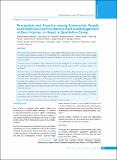Please use this identifier to cite or link to this item:
https://hdl.handle.net/20.500.14356/1405Full metadata record
| DC Field | Value | Language |
|---|---|---|
| dc.contributor.author | Bhandari, Santosh Bikram | - |
| dc.contributor.author | Sah, Sujit Kumar | - |
| dc.contributor.author | Bhandari, Khakindra Bahadur | - |
| dc.contributor.author | Sakya, Jaswan | - |
| dc.contributor.author | Pathak, Laxmi Raj | - |
| dc.contributor.author | Ghimire, Sudha | - |
| dc.contributor.author | Devkota, Bhimsen | - |
| dc.contributor.author | Hussmann, Jurgen | - |
| dc.contributor.author | Lohmann, Rudiger | - |
| dc.date.accessioned | 2023-05-10T06:29:23Z | - |
| dc.date.available | 2023-05-10T06:29:23Z | - |
| dc.date.issued | 2019 | - |
| dc.identifier.citation | BhandariS. B., SahS. K., BhandariK. B., SakyaJ., PathakL. R., GhimireS., DevkotaB., HussmannJ., & LohmannR. (2019). Perception and Practice among Community People and Health Service Providers on Care and Management of Burn Injuries in Nepal: A Qualitative Study. Journal of Nepal Health Research Council, 17(3), 315-319. https://doi.org/10.33314/jnhrc.v17i3.1640 | en_US |
| dc.identifier.issn | Print ISSN: 1727-5482; Online ISSN: 1999-6217 | - |
| dc.identifier.uri | http://103.69.126.140:8080/handle/20.500.14356/1405 | - |
| dc.description | Original Article | en_US |
| dc.description.abstract | Abstract Background: According to WHO, burns are a serious public health problem and the second most common cause for injury in rural Nepal, accounting for 5% of disabilities. The overall objective of the study is to assess the prevailing perception and practice among community people and health service providers on care and management of burn injuries in Nepal. Methods: This was a qualitative study conducted in 2016 representing all eco-development regions. A total of 40 key informants interviews with health personnel and 18 focus group discussions with the community people were conducted. Results: There are very limited dedicated burn care facilities in Nepal. During discussion, the service providers and community people mentioned that a burn injury can affect any one irrespective of their age and socioeconomic status. The study showed that females are at higher risk for burn injury which is associated mostly with wood fire cooking.The burn cases in the hospitals were more during winter than insummer season. Among all the ethnic groups, Dalit and indigenous population were found more vulnerable towards burn injuries. Intentional burn injuries such as self-inflicted burns/suicidal attemptwere found to occur more in females.The community people had a good practice of taking the majority ofpatients having burn injury immediately to the hospital,if not, they at least provided them with a first aid treatment. Conclusions: Majority of burn injured cases are getting first aid treatment at the incident places and taking hospital immediately. Main reasons, who reached late, are unaware about seeking services and financial constraint. Overall, the community people are partially aware about the burn injury. Keywords: Burn injuries; community practice; hospitals; incident and types. | en_US |
| dc.language.iso | en | en_US |
| dc.publisher | Nepal Health Research Council | en_US |
| dc.relation.ispartofseries | July-Sep, 2019;1640 | - |
| dc.subject | Burn injuries | en_US |
| dc.subject | Community practice | en_US |
| dc.subject | Hospitals | en_US |
| dc.subject | Incident and types | en_US |
| dc.title | Perception and Practice among Community People and Health Service Providers on Care and Management of Burn Injuries in Nepal: A Qualitative Study | en_US |
| dc.type | Journal Article | en_US |
| local.journal.category | Original Article | - |
| Appears in Collections: | Vol. 17 No. 3 Issue 44 Jul-Sep 2019 | |
Files in This Item:
| File | Description | Size | Format | |
|---|---|---|---|---|
| 1640-Manuscript-12202-1-10-20191114.pdf | Fulltext Download | 243.48 kB | Adobe PDF |  View/Open |
Items in DSpace are protected by copyright, with all rights reserved, unless otherwise indicated.
